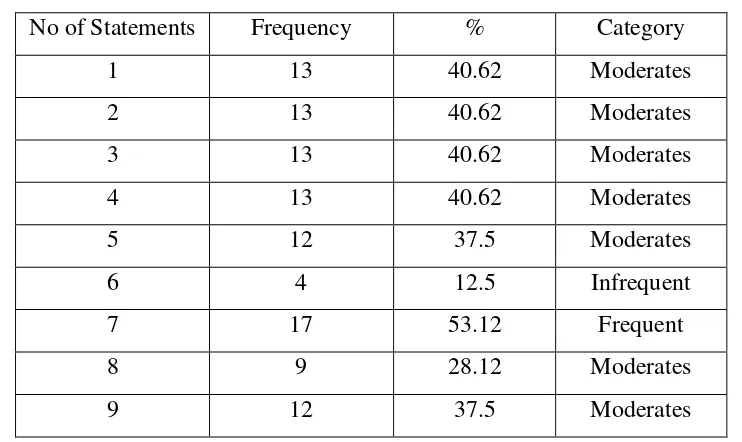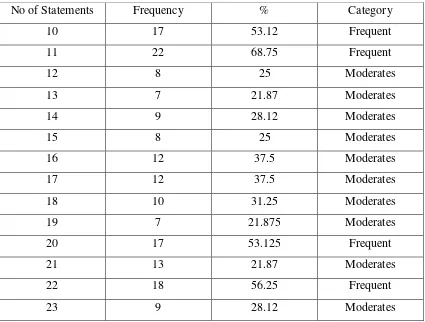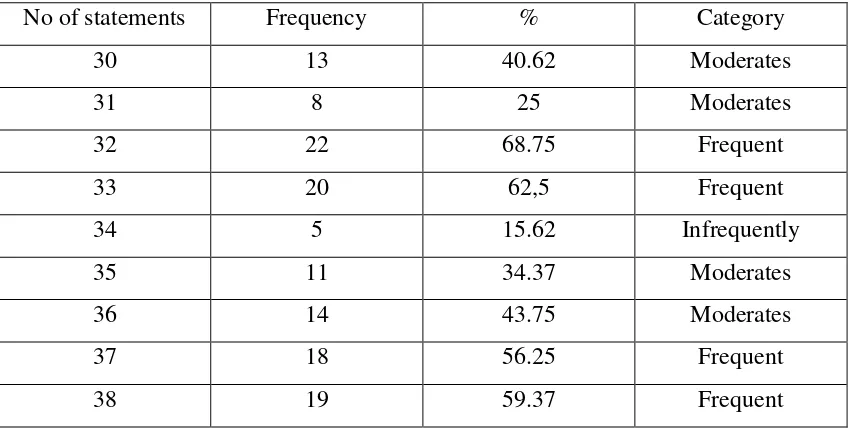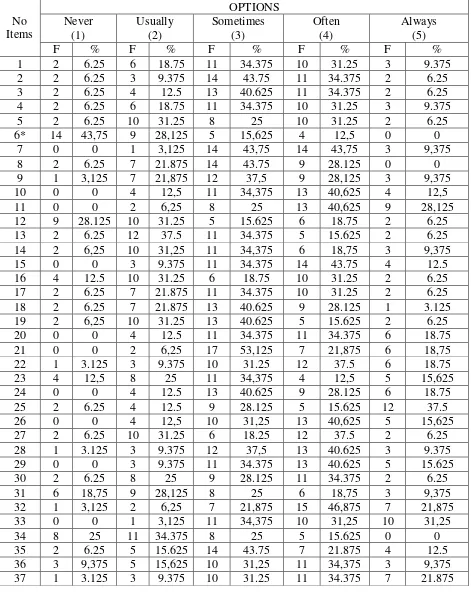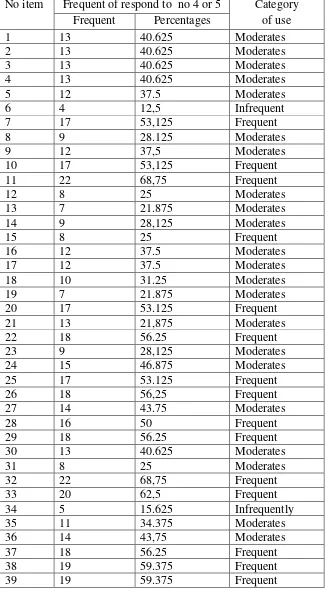CHAPTER IV
RESULTS AND DISCUSSION
4.1 Result
In this chapter, the researcher described the finding or the result of English language learning strategies used by successful non-English department students. It mainly covers the discussion of the frequent English language learning strategy statements applied and the dominant group of English language learning strategy used by the students. As the researcher has mentioned in Chapter Two, the strategy was divided into two general parts, direct and indirect. Direct strategy consists of memory, cognitive, and compensation strategy. Meanwhile, indirect strategy consists of metacognitive, affective, and social strategy. In order to answer the research question, the researcher used questionnaire as the main instrument of this research. Questionnaire was taken from SILL 7.0. There are strategy statements (1–50) from SILL version 7.0 on questionnaires and that you can look at appendix 1.
4.1.1 Applied of English language learning strategy statements
belong to SILL 7.0 were applied in frequent level, 25 statements were applied in moderate level, and 5 statements were applied as in infrequent level.
From the 50 statements on the SILL 7.0, there were two highest frequencies of English language learning statements applied by successful non-English students. The first highest is statement number11“saya mencoba berbicara seperti penuntur asli bahasa inggris, dengan cara meniru dialog dalam film atau acara tv yang mengunakan bahasa inggris”. The statement number 11 was included in cognitive strategy with 22
or 68.75% student srespond“often” or “always”. The otherhighest oneis statement number 32 “saya memperhatikan seseorang yang berbicara dalam bahasa inggris”. Statment number 32 was included in compensation with 22 or 68.75% students was respond “often” or“always”.
On the other hand, the result showed the lowest frequency of English language learning strategy statements applied by students is statement number 6 “Saya mengunakan kartu untuk mengingat kata kata baru dalam bahasa inggris”. The
statement number 6 was included in memory strategy with only four (4) or 12.5 % students respond “often” or “always”.
The result of the highest and lowest English language strategy statement applied was mention above. To make it clear and detail, the researcher divided the level of use of each strategy in every group strategy. See as following table shows:
Table 4: Frequency of memory strategy statements applied by successful non-English department students
No of Statements Frequency % Category
1 13 40.62 Moderates
2 13 40.62 Moderates
3 13 40.62 Moderates
4 13 40.62 Moderates
5 12 37.5 Moderates
6 4 12.5 Infrequent
7 17 53.12 Frequent
8 9 28.12 Moderates
9 12 37.5 Moderates
From the table 4, it can be seen that statement 7 was applied frequently, statement 6 was applied infrequently, and statements 1, 2, 3, 4, 5, 8, and 9 were applied moderately by successful non-English department students. When the highest applied was statement number 7 (Saya memperaktekkan kata baru bahasa Inggris yang baru saya ketahui) with 17 or 53.12% students respond“often” or “always” (respond 4 or 5). Then the lowest applied by students in the memory group strategy was statement number 6 ( saya menggunakan kartu untuk mengingat kata baru dalam bahasa inggris) with just 4 or 12.5% students respond “often” or “always”. It meant the students moderately applied the statements included in memory strategy.
Table 5: Frequency of Cognitive Strategy Statements Applied by Successful non-English department students
No of Statements Frequency % Category
10 17 53.12 Frequent
11 22 68.75 Frequent
12 8 25 Moderates
13 7 21.87 Moderates
14 9 28.12 Moderates
15 8 25 Moderates
16 12 37.5 Moderates
17 12 37.5 Moderates
18 10 31.25 Moderates
19 7 21.875 Moderates
20 17 53.125 Frequent
21 13 21.87 Moderates
22 18 56.25 Frequent
23 9 28.12 Moderates
The third, in compensation strategy the successful non-English students were frequent in applied of compensation strategy statements.
Table 6: Frequency of compensation strategy statements applied by successful non-English department students
No of statements Frequency % Category
24 15 46.87 Moderates
25 17 53.12 Frequent
26 18 56.25 Frequent
27 14 43.75 Moderates
28 16 50 Frequent
29 18 56.25 Frequent
From the table 2c, it can be seen that statements 24, 27 were applied as moderately, and statements 25, 26, 28, and 29 were applied frequently. Statements number 26 (Saya membuat kata kata baru jika saya tidak tahu artinya dalam bahasa inggris) and 29 (saya mengunakan kata yang hampir sama artinya atau bersinonim jika saya tidak tahu arti kata tersebut dalam bahasa inggris) was the highest applied by students with 18 students or 56.25 % respond“often”or “always”(respond 4 or 5). With no big different percentages applied between strategy statements in compensation strategy, it means the strategy statements applied in this strategy were more spread by the students.
Table 7: Frequency of meta-cognitive strategy statements applied by successful non-English department students
No of statements Frequency % Category
30 13 40.62 Moderates
31 8 25 Moderates
32 22 68.75 Frequent
33 20 62,5 Frequent
34 5 15.62 Infrequently
35 11 34.37 Moderates
36 14 43.75 Moderates
37 18 56.25 Frequent
38 19 59.37 Frequent
From the table 7, it can be seen that statement 34 was applied infrequently, statements 30, 31, 35, and 36 were applied as moderately, and statements 32, 33, 37, and 38 were applied as frequently. Statement number 32(Saya memperhatikan seseorang yang berbicara dalam bahasa inggris) was the highest frequent applied by them with 22 or 68.75 % students respond “often”or “always” (respond 4 or 5). And the lowest statement applied was strategy number 34 (Saya merencanakan jadwal belajar sehingga saya memiliki waktu yang cukup dalam belajar bahasa inggris) with 5 or 15. 62 % students respond “often”or “always”.
Table 8: Frequency of Affective strategy statements applied by successful non-English department students
No of statements Frequency % Category
39 19 59.37 Frequent
40 18 56.25 Frequent
41 6 18,75 Infrequent
42 5 15.62 Infrequent
43 6 18.75 Infrequent
44 9 28.12 Moderate
From the table8, it can be seen that statements 41, 42, and 43 were applied infrequently, only statement number 44 applied moderately and statements 39 and 40 were applied frequently. When Statements number 41 (Saya menyenangkan diri saya dengan hadiah ketika saya sudah lebih baik dalam berbahasa inggris, Contohnya kalo saya dapat nilai A pada mata kuliah bahasa inggris saya akan pergi liburan) and 43 (Saya menulis berbagai persaan saya ke dalambuku harian mengunakan bahasa inggris) only six or 18.75 % students respond “often” or “always” (respond 4 or 5), and statement number 42 (Saya menandai atau mencatat ketika saya gugup dalam berbahasa inggris atau belajar bahasa inggris) only five or 15.62% students respond “often” or "always”. Many statements in affective strategy applied infrequently by
successful non-English department student, it meant the affective strategy is not habitually used by them.
Table 9: Frequency of social strategy statement applied by successful non-English department students
No of statements Frequency % Category
45 21 65.62 Frequent
46 16 50 Frequent
47 15 46.87 Moderates
48 19 59.37 Frequent
49 13 40.62 Moderates
50 18 56.25 Frequent
From the table 9, it can be seen that statements 47 and 49 were applied as moderately, and statements 45, 46, 48, and 50 were applied as frequently. Statement number 45 (Ketika saya tak mengerti maksud bahasa inggris yang di sampaikan seseorang saya akan memintanya untuk mengulangi dan memperlambat ucapanya) was the highest frequent applied with 21 or 65.62%students respond “often” or “always”. Many strategy statements in social strategy applied frequently by
successful non-English department student, it meant the social strategy was habitually used by them.
4.1.2 The most frequently used of English language learning strategies
Chart: frequently used of English language learning strategies
From the chart above, it showed that the average score for each group of English language learning strategy, when compensation and social strategy was the dominant group of English language learning strategies used by successful non-English department students. Compensation strategy was dominant strategy used by students with average score of 3.49.It is matched with what respondent said in interview session. Conversely, the social strategy did not have big difference with compensation strategy with average score of 3.47.
Based on the interview with some respondents, the researcher knew every interview respondent would always or often guess the word if they did not know the English words. Guessing the English word meaning was also categorized as compensation strategy. The respondents would guess the words by following the context of sentences or the article. All of the students said similar answers about the interview questions no 4, as for example, one of them said:“saya jarang buka kamus
sih jadi cuma nebak aja + guesing + ini kalimat bicara tentang topic apa + berarti
kira kira ini artinya”.
Based on the interview session which was related to social strategy question, the researcher found that most of the students wanted to learn with social interaction. The students were more comfort if they learned with their friends; if they learned together they could discuss about the problem, solution, evaluation, and could have many activities in learning English. As for example, one of them said: “A; apakah mbak biasnya belajar bahasa inggris sendiri atau bareng temen? B: sama temen+
biar ada yang benerin ++ kalo sama temen bisa langsung praktek”. On the contrary,
in the real situation few students’ friends could be as the partner in learning English because their background knowledge was not English or not many of their friends were interesting in English. so this will make students learn individually the Students who were from agriculture faculty said to the researcher that they wanted to learn English with friends, but that was hard to find any friend in his department who had similar interest in English. Their friends were not really interested in learning English. Hence, they would only learn individually or find any friend with same interest in English who was not in his department.
This interview data covering social strategy, one of them said:
mahasiswanya gak terlalu ini banget kan + gak terlalu penting kalo kata mereka + jadi kalo ngomong bahasa inggris th kadang kdang di bilang sok atau sombong+ nah gitu lah jadinya”
In other interview session, the researcher has talked with students in faculty of medicines. They said, they learned English indvidully, but if they find friend in same interst their will learn together.It meant students prefer learning English with friends, but the condition should make them learning English individually.
Whereas metacognitive strategy used by successful non-English department students are with average score is 3.23. In the questionnaire, the level was the use of meta-cognitive was moderate to frequent, it means successful non-English students department several times used metacogniteve strategy.
On the other hand, in interview session some respondents said they were not ever intent to plan, organization, and evaluate in learning English. That explained the result of questionnaire was not relevant with the interview result. The respondents said their never make schedule in learning English during they study in Universitas Bengkulu, but they planned in learning English during they study in school. The reason was, during they study at university English course did not meet in every week, but in school they only met twice in a week. One of the student’s statements was:
“ kalo pas SMA sih iya+ kan mesti ktemu tiap minggu+ jadi ya pasti belajar nya di jadwalin++ tapi kalo kuliah ngak lagi+ paling berapa semster aja ktemu+ jadi ngak begitu jadi fokus buat di rencanain belajar”
frequent strategies used by successful non-English department memory strategy level was moderately and cognitive strategy level was also moderately. It meant both of strategies were sometimes used by all successful not English students department.
In interview session the researcher found a fact that the respondents did not learn English again what was learnt in other times. It mean that memory did not overplay used by students. The memory strategy sometimes was used by all successful non-English department students. Students often followed what they listened especially when watching English movie. All of the students said similar answers about the learning again at other times. As can be seen:
“A: apakah selalu mngulangi pelajaran bahasa inggris yang baru di pelajari di lain waktu? B: kadang kadang sih+ kalo di ulangi yang saat untuk belajar sih enggak++ tapi kalo pas untuk mengunakanyasih iya”
The respondent liked to follow the pronunciation, style act, and unique words when they were watching English movie. Promulgating what they listened when watching English movie was also included as cognitive group strategy.
Affective strategy had the lowest of average score than five other strategies group. The average scores of affective strategies were just 2.65. It meant all successful non-English department students were not dominant using affective strategy. Based on the interview the researcher found that most of respondent never gave themselves reward if they could get good achievement during learning English the motivation was from their inner self. One of the student’s statements was: “ngak terlalu+ memotivasi diri saya dengan menggap pelajaran bahasa inggris itu sangat
penting++ sudah ada dalam diri+ jadi tak terlalu membutuhkan motivasi dari
treatment for herself. In another words, successful non-English department students were not giving special focus to using affective strategies. That could be seen based on the average score in each group strategy.
4.2 Discussion
First, the most frequent English learning strategies used by successful non-English department students was compensation strategy. Majority of the successful non-English department students were more frequently used this strategy among all of strategies in learning English. The compensation strategy was used habitually by successful non-English department student, because the result showed statements in this strategy are majorly frequent applied by them. It is consistent with interview session, the students said that they will often to do guessing the word when did not know the English word based on context or sentences. According to Oxford (1990) Compensation strategy is guessing or using synonyms, allowing learners to use the language despite their often large gaps in knowledge. It can be conclude compensation strategy is used by most of successful non-English department student probably because it is more simple strategy just guessing the word based on the context. It is difference while using other strategies, because the others strategy needs more physical action to do or spend more times. Compensation was dominant strategy used by successful non-English department students without having many average score difference between social and compensation strategy.
(1990) social strategy helps students learn through interaction with others with giving question, asking clarification, and asking for correction. The students were aware about the benefit of using social strategy can see at interview. In interview session, students said that they liked learning with their friends because the students were more comfort if they learned with their friends. It gave reasons why social was being dominant group strategy used, because if they learned together they could discuss about the problem, solution, evaluation, and could have many activities in learning English
Third, the most frequent English language learning strategies used by successful non-English department students was Metacognitive strategy. In the questionnaire result, the metacognitive just used as sometimes in learning English. Purupura in Brown (2007) defined metacognitive strategy as a term used in information-processing theory to indicate an “executive” function, monitoring of one’s production or comprehension, strategies that involve planning for learning,
If the focus is only on general strategies which was direct and indirect strategy based on Oxford (1990) the students’ dominant direct strategy used was
compensation strategy. If they learn English and need more preparation, they were dominantly used social strategy.
CHAPTER V
CONCLUSIONS AND SUGGESTION
5.1 Conclusions
Based on the result of this research, the researcher can conclude that there were frequency of English language learning strategies statements applied and the dominant group strategy used by non-English department students. They are:
A. the dominant group of English language learning strategies used
1. The first frequently used English language learning strategies by successful non-English department was the Compensation strategy with the average score 3.49
2. The second frequently used English language learning strategies by successful non-English department students was the Social strategy with average score 3.47.
3. And the third frequently used English language learning strategy by successful non-English department students was the Metcognitive strategy with average score 3.23
5.2 Suggestion
1. Referring to the result of this study, it was suggested that the English lecturers at Universitas Bengkulu need to guide their students in using appropriated language learning strategies. Lecturers can make English class more interactive class.
2. For the students, the researcher suggests to use more social and compensation strategy in learning English. Students should increase their English group activity with their friends.
REFERENCES
Arikunto, Suharsimi. (1998). Prosedur Penelitian Suatu Pendekatan Praktek. Jakarta;Rineka Cipta.
Arikunto.Suharsimi. (1998).Evaluasi Dasar – Dasar Kependidikan. Jakarta:Rhineka Cipta
Brown, Douglas.H. (2007). Principles of Language Learning And Teaching: fifth edition.san francisco. Pearson longman.
Cohen, Andrew D. (1998). Strategies In Learning and Using Second Language. New York. Addison Weseley Longman Inc.
Chamot, A.U. (2004).Issues in Language Learning Strategy Research and teaching.Centre for Language Studies National University of Singapore,
1(1). 14-26.
Hamalik, Oemar. (2004).Proses Belajar Mengajar. Jakarta: PT Bumi Aksara
Hutchison, Tom and waters, Alan. (1987). English for Specific Purposes a Learning-Centered Approach. Sidney: Cambridge University Press. Publishing Company, Inch.
Junaidi. (1998). Language learning strategy preference of the English department students at universitas Bengkulu. Bengkulu: universitas Bengkulu (unpublished)
Khalid. (2005). English Learning Language Strategies Used by Diploma Three (D3) English Department Students of Universitas Bengkulu Academic Year 2005-2006.Bengkulu; universitas Bengkulu. (Unpublished)
Miller, Jennifer. (2013). 5 Reason Why Learning English Is Important, Whatever Your Age. http://WWW.uncommonchildhood.com/5-reasons-why-learning english-is-important-whatever-your-age/ Retrieved 22 January 2014 Macaro, Ernesto. (2001). Learning strategies in Foreign and second Language
classrooms. New York. Continuum.
Oxford, R.L. (1990). Language learning strategies: what Every Teacher should know. Boston: M.A Heinline and HeinlinePublisher.
Pressley, M. and Mccormick, C.B., 1995: Advanced Educational Psychology for Educators, Researchers, and Policymakers. New York: Harper Collins.
Richards, Jack C and Schmidt, Richard. (1985).Longman Dictionary of Lanuage Teaching & Applied Linguistic. (4thed.).Great Britain : pearson education limited.
Rubin & Thompson. (2004). What the Good Language Learner can Teach Us.
http://language.com.hk/articles/goodll.htmlretrived 16 january 2014
Questionnaire
Nama :
Fakultas/jurusan :
NPM :
Dibawah ini ada beberapa pernyataan (pernyataan 1 sampai 50), pernyataan tersebut bertujuan untuk mendapatkan informasi bagaimana strategi belajar bahasa Inggris yang kamu lakukan.Bacalah masing masing pernyataan tersebut dengan seksama. Isilah kolom (1,2,3,4, dan 5) yang berada di sebelah kanan pernyataan dengan memberikan tanda (√) berdasarkan pengalam belajarmu atau yang biasa kamu lakukan dalam belajar bahasa Inggris.
Pilihan katanya adalah:
1 Saya memikirkan hubungan antara kata bahasa Inggrisyang saya ketahui dengan yang baru saya pelajari
2 Saya mengunakan kata bahasa Inggrisyang baru saya ketahui ke dalam kalimat bahasa Inggris yang saya buat sehingga mempermudah saya mengingat kata baru tersebut
3 Saya menghubungkan kata bahasa Inggris yang baru saya dengar dengan membayangkannya atau menghubungkanya dengan gambar sehingga saya mudah meningatnya
4 Saya mengingat kata baru bahasa Inggris dengan membuat gambaran situasi di mana kata tersebut digunakan
5 Saya menggunakan kesamaan bunyi dalam kata yang berbeda untuk mengingat kata kata baru bahasa Inggris
6 Saya mengunakan kartu untuk mengingat kata kata baru dalam bahasa Inggris 7 Saya memperaktekan kata bahsa Inggris baru yang baru saya ketahui
8 Saya sering mengulangi pelajaran bahasa Inggris yang telah saya pelajari 9 Saya mengingat kata baru bahasa Inggris atau prase-prase dengan mengingat
lokasi mereka pada dalam halaman buku, papan tulis, atau pada tanda jalan
Cognitive strategy 1 2 3 4 5
10 Saya mengucapkan atau menulis kata-kata bahasa Inggris berberapa kali 11 Saya mencoba bicara seperti penutur asli bahasa Inggris. Dengan cara meniru
dialog dialog dalam film vcd atau film di tv yang mengunakan bahasa Inggris 12 Saya melatih pengucapan bunyi bahasa Inggris seperti merekam suara saya
dalam kaset tape kumudian mendengarkannya
13 Saya mengunakan kata kata bahasa Inggris yang saya ketahui pada kalimat yang berbeda-beda
14 Saya biasanya memulai percakapan dengan bahasa Inggris untuk berlatih 15 Saya menyaksikan acara dan film tv atau film bioskop yang mengunakan
bahasa Inggris
16 Saya memebaca majalah atau novel bahasa Inggris yang ceritanya meneyenangkan
17 Saya berlatih bahasa Inggris dengan menulis catatan, pesan-pesan,atau laporan-laporan dalam bahasa Inggris
18 Saya membaca dengan cepat bacaan bahasa Inggris kemudian mengulangi lagi dan membacanya berhati hati
19 Saya mencari kata kata dalam bahasa Indonesia yang diadopsi dari kata kata bahasa Inggris
20 Saya mencari cara belajar bahasa Inggris dengan pola saya sendiri 21 Saya menemukan arti kata bahasa Inggris dengan menjadikan bagian per
bagian sehingga dapat saya mengerti
22 Saya mencoba untuk tidak menterjemahkan kata perkata
23 Saya membuat ringkasan dari informasi yang saya dengar atau saya baca dalam bahasa Inggris
Compensation strategy 1 2 3 4 5
24 Untuk memahami kata bahasa Inggris yang tidak saya ketahui dengan menebaknya
25 Ketika saya tidak mengetahui kata bahasa Inggris yang ingin saya ucapkan pada saat percakapan bahasa Inggris sayamenggunakan gestur tubuh untuk mengungkapkanya
26 Saya mengunakan kata kata lain untuk membuat orang mengerti maksud atau kata yang mau saya ucapakan tapi saya tidak mengetahui bahasa Inggrisnya 27 Saya membaca bacaan berbahasa Inggris tanpa mencari arti atau
memperhatikan kata kata baru dalam bahasa Inggris yang belum di ketahui 28 Saya mencoba menebak apa yang akan di katakan seseorang dalam bahasa
Inggris
29 Saya mengunakan kata yang hampir sama artinya (bersinonim) jika saya tidak tahu arti kata tersebut dalam bahasa Inggris
Metacognitive strategy 1 2 3 4 5
30 Saya mencari sebanyak mungkin cara atau kesempatan sehingga saya dapat mengunakan bahasa Inggris
31 Saya mencatat kesalahan saya dalam berbahasa Inggris. Dan menggunakan catatan itu supaya saya tak mengulangi kesalahan
33 Saya mencoba menemukan cara agar bisa berbicara bahasa Inggris dengan lebih baik
34 Saya merencanakan jadwal belajar sehingga saya memiliki waktu yang cukup dalam belajar bahasa Inggris
35 Saya mencari orang yang bisa saya ajak berbicara atau berlatih dalam bahasa Inggris
36 Saya mencari kesempatan sebanyak mungkin untuk membaca dalam bahasa Inggris
37 Saya mempunyai tekat atau tujuan belajar bahasa Inggris yang jelas sehingga dapat meningkatkan skill berbahasa Inggris saya
38 Saya memikirkan kemajuan atau meningkatkah kemampuan saya dalam berbahasa Inggris
Affective Strategy 1 2 3 4 5
39 Saya mencoba santai walaupun saya merasa takut atau khawatir dalam mengunkan bahasa Inggris
40 Saya memberikan dorongan pada diri sendiri untuk berbicara dalam bahasa Inggris meskipun sebenaranya saya takut atau khawatir membuat kesalahan 41 Saya menyenangkan diri saya dengan hadiah ketika saya sudah lebih baik
dalam berbahasa Inggris. Contohnya kalo saya dapat nilai A pada mata kuliah bahasa Inggris saya akan pergi liburan
42 Saya menandai atau mencatat ketika saya gugup dalam berbahasa Inggris atau belajar bahasa Inggris
43 Saya menulis berbagai perasaan saya ke dalambuku harian mengunakan bahasa Inggris
44 Saya mengatakan pada orang lain tentang perasaan saya (takut senang, biasa saja) ketika belajar bahasa Inggris
Social Strategy
45 Ketika saya tak mengerti maksud bahasa Inggris yang di sampaikan seseorang saya akan memintanya untuk mengulangi dan memperlambat ucapanya 46 Saya meminta orang yang mengunakan bahasa Inggris dengan baik (dosen,
orang asing, teman) untuk mengoreksi pada saat saya berbicara dalam bahasa Inggris
47 Saya memperaktekan bahasa Inggris dengan mahasiswa lainya 48 saya meminta bantuan orang yang lebih ahli berbahasa Inggris untuk
membantu saya dalam belajar bahasa Inggris
49 Saya mengunkan bahasa Inggris ketika saya inggin bertanya pada saat belajar bahasa Inggris
Questionnaire
Nama :
Fakultas/jurusan :
NPM :
Dibawah ini ada beberapa pernyataan (pernyataan 1 sampai 50), pernyataan tersebut bertujuan untuk mendapatkan informasi bagaimana strategi belajar bahasa inggris yang kamu lakukan. Bacalah masing masing pernyataan tersebut dengan seksama. Isilah kolom (1,2,3,4, dan 5) yang berada di sebelah kanan pernyataan dengan memberikan tanda (√) berdasarkan pengalam belajarmu atu yang biasa kamu lakukan dalam belajar bahasa inggris.
1 I think of relationship between what I already know and new thing I learn in English
2 I use the English word in sentence so I can remember them
3 I connect the sound of a new English word and an image or picture of the word to help me remember the word
4 I remember a new English word by making mental picture of a situation in which the word might be used
5 I use rhymes to remember new English word 6 I use flash card to remember new English word 7 I physically act out new English word
8 I review english lesson often
9 I remember new English word or phrase by remembering their location on the page, on the board, or on a street sign
Cognitive strategies 1 2 3 4 5
10 I say or write new English word several times 11 I try to talk like native English speakers 12 I practice the sound of English
13 I use the English word I know in different ways 14 I start conversation in English
movie spoken English
16 I Read For Pleasure In English
17 I writes note, messages, letters, or report in english
18 I first skim an English passage (read over the passage quickly) then go back and read carefully
19 I look for word in my own language that are similar to new word in English
20 I try to pattern in English
21 I find the meaning of an English word by dividing it into parts that I understand
22 I try not to translate word- for- word
23 I make summaries of information that I hear or read in English
Compensation strategies 1 2 3 4 5
24 To understand unfamiliar English word, I make guess.
25 When I can’t think of a word during a conversation in English, I use gesture
26 I make up new word if I do not know the right one in English 27 I read English without looking up every new word
28 I try to guess what the other person will say next in English 29 If I can’t think of an English word, I use a word or phrase that
means the same thing
Metacognitive strategies 1 2 3 4 5
30 I try to as many ways as I can use my English
31 I notice my English mistake and use that information to help me do better
32 I pay attention when someone is speaking English 33 I try to find out how to be better learner of English
34 I plan my schedule so I will have enough time to study English 35 I look for people I can talk to in English
36 I look for opportunities to read as much as possible in English 37 I have to clear goals for improving my English skills
38 I think about my progress in learning English
Affective Strategies 1 2 3 4 5
39 I try to relax whenever I feel afraid of using english
40 I encourage myself to speak English even when I am afraid of making a mistake
41 I give myself reward or treat when a do well in English 42 I notice if aim tense or nervous when I am studying or using
English
43 I write down my felling in a language learning diary
45 If I don’t understand something in English, I ask to other person to slow down or say it again
46 I ask English speaker to correct me when I talk 47 I practice English with other students
48 I ask for help from English speakers 49 I ask question in English
Interview Questions
1. Apakah mengimajinasikan kata baru bahasa Inggris membuatmu lebih mengerti?
2. Apakah anda selalu mengulangi setiap pelajaran bahasa Inggris?
3. Apakah anda sering mengikuti pengucpan yang anda dengar waktu menonton film berbahasa Inggris?
4. Apakah anda selalu menebak arti kata bahasa Inggris ketika tidak tahu artinya?
5. Apakah anda selalu menyusun rencana belajar bahasa Inggris dan mengevaluasinya?
6. Apakah anda memberi rangsangan untuk lebih tremotivasi saat belajar bahasa Inggris?
7. Apakah Lebih nyaman belajar bahasa Inggris sendiri? validitas dari instrument wawancara sudah terpenuhi
Sincerely
Kasmaini S.S.,M.Pd.
38 0 0 4 12.5 9 28.125 12 37.5 7 21.875
39 1 3.125 4 12.5 8 25 16 50 3 9.375
40 1 3.125 6 18.75 7 21.875 14 43.75 4 12.5
41 15 46,875 4 12,5 7 21,875 5 15,625 1 3,125
42 11 34.375 9 28.125 7 21.875 3 9.375 2 6.25
43 13 40,625 8 25 5 15,625 6 18,75 0 0
44 8 25 8 25 7 21.875 6 18.75 3 9.375
45 0 0 2 6.25 9 28.125 13 40.625 8 25
46 1 3,125 7 21,875 8 25 11 34,375 5 15,625
47 2 6.25 5 15.625 10 31.25 10 31.25 5 15.625
48 1 3.125 3 9.375 9 28.125 15 46.875 4 12.5
49 3 9.375 4 12.5 12 37.5 9 28.125 4 12.5
40 18 56.25 Frequent
41 6 18,75 Infrequently
42 5 15.625 Infrequently
43 6 18,75 Infrequently
44 9 28.125 Moderates
45 21 65.625 Frequent
46 16 50 Frequent
47 15 46.875 Moderates
48 19 59.375 Frequent
49 13 40.625 Moderates
Average scores of group strategy
Students Memory Cognitive Compensation Metacogniteve Affective Social
